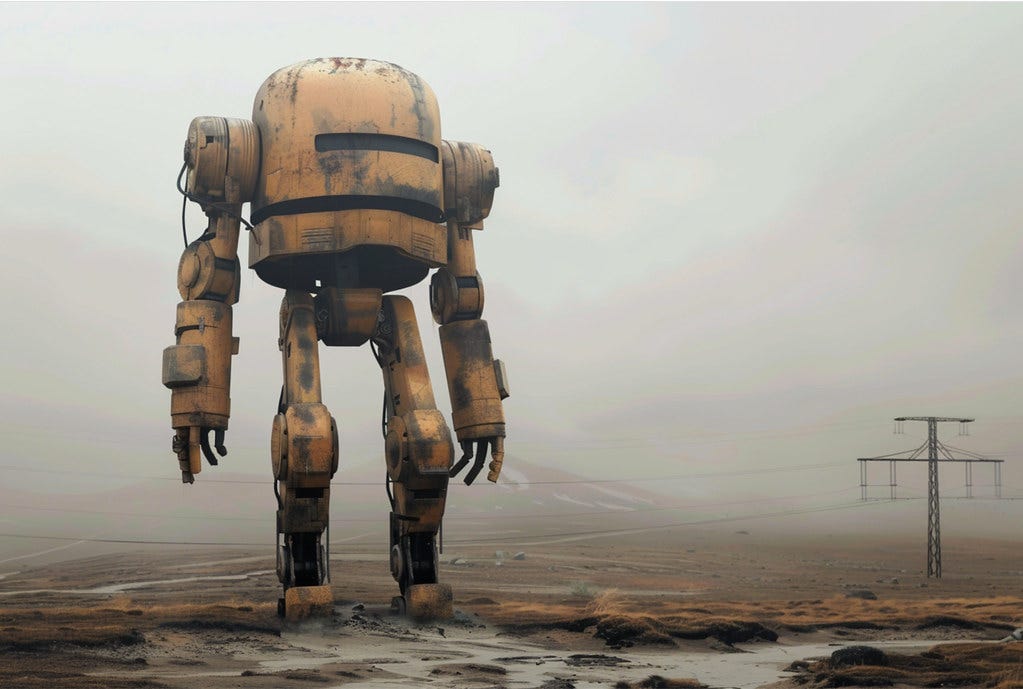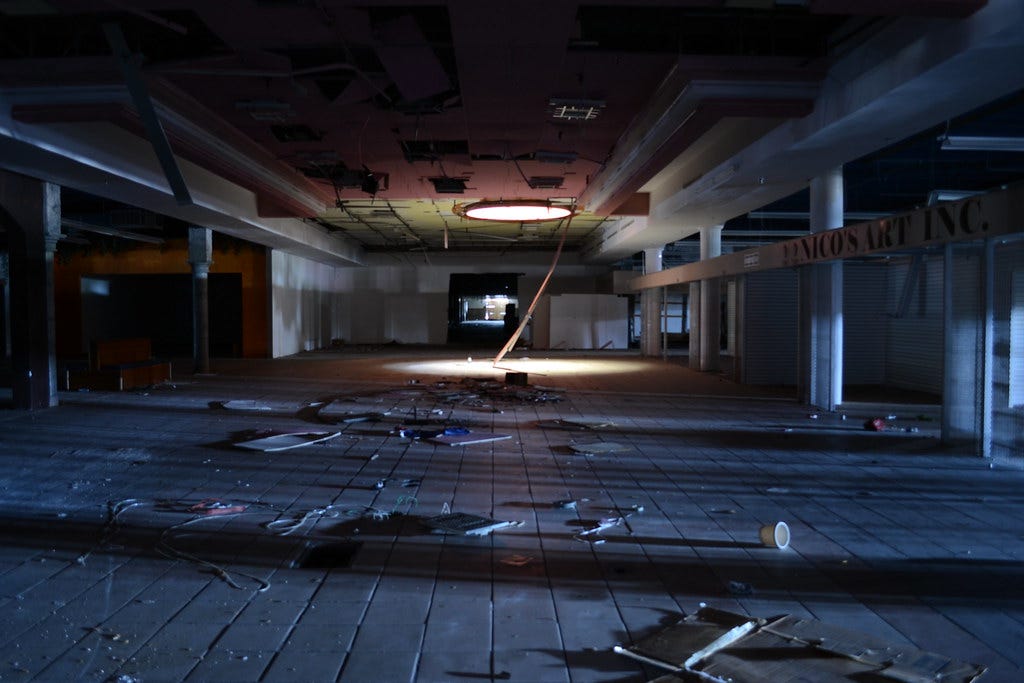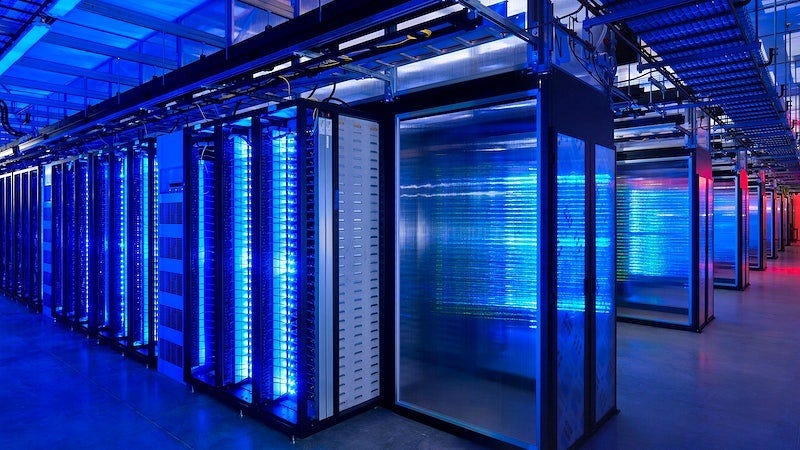Movie neurobabble: The Electric State
I had to watch Netflix's incredibly expensive flop The Electric State. Among the many things wrong with it was some very dubious brain science. So here I am to tell you about that.

[Warning: multiple spoilers ahead, insofar as it’s possible to spoil this one]
Once again, I have watched a move for the Smersh Pod podcast, with host John Rain and fellow Welsh comic person Dan Thomas. This time it’s the very recent ‘The Electric State’, on Netflix. And once again, I’ve opted to write about it at length.
In theory, it’s a move adaption of the graphic novel/story/book1 of the same name by celebrated artist Simon Stålenhag, who happens to be my favourite visual artist.
In practice… well, you could say that the film lacks the eerie dystopic melancholy of the book, and doesn’t quite manage to convey the sense of high-tech societal decay via the sweeping vistas of the US.
This would be an extremely generous assessment, though. It would be fairer to say it takes Stålenhag’s compelling visual style, and slaps it on an action adventure that happens to include robots, which somehow manages to be both painfully generic and deeply confusing.
In short, The Electric State? The Electric State of it, more like!
Anyway, there are two particularly glaring neuroscientific boondoggles in this film. One relatively throwaway, one central to the plot, but both equally revealing of a severe paucity of neuro-knowledge. So, here is some more movie neurobabble.
Film: The Electric State
Starring: Mille Bobbie Brown, Chris Pratt, Anthony Mackie, Stanley Tucci, and a whole load of other very prominent people who you would have assumed couldn’t need the money this badly.
Director: The Russo Brothers.
Plot Summary: It is an alternate-timeline 19942, one where Walt Disney developed artificial intelligence and sentient robots, rather than rudimentary animatronics, for his theme parks. A level of overkill tantamount to constructing a cold-fusion reactor to power your Christmas tree lights.
Thus, intelligent robots of all shapes and sizes become commonplace, before predictably rebelling, leading to a classic man-vs-machine war, in the continental United States3. Machines dominate at first, but humans eventually prove victorious when tech-bro industrialist Ethan Skate invents ‘Drone’ technology. Not the perpetually annoying airport-closing flying gizmos, but robotic bodies that humans can pilot ‘remotely’, via technology named ‘Neurocasters’.
Basically, people can project their consciousness into a sturdy robotic host many miles away, making combat a much more relaxing affair.
After the leader of the machines, a Woody Harrelson-voiced Mr Peanut robot (yes, really4) signs a surrender treaty, robots are restricted to a vast area in the American desert, the ‘electric state’ of the title, presumably.
The rest of the US carries on in a form that is somehow a decaying dystopia where nobody makes anything any more, and an extremely advanced technocracy, at the same time.
Regarding actual characters, before the war, teenager Michelle (Millie Bobbie Brown) is helping her younger brother tour a prestigious university. Harvard, I think? Honestly, it doesn’t matter.
Because tests reveal her younger brother is one of the smartest humans to have ever existed, something which manifests as him being, in an unprecedented move, a socially awkward, geeky teenager, wearing a t-shirt of his favourite cartoon character, a robot named Kid Cosmo.
Anyway, mid-war, Michelle and her family hit a deer with their car, which results in her waking up in hospital to be told that she’s the only one who survived.
Returning to the present (1997), Michelle is now a troubled student living with her foster carer, Ted (Jason Alexander), an inexplicable character that can be best defined as ‘comic relief who also happens to be an abusive pervert’.
Ted gives Michelle a hard time about everything, via his drone body. Because drone tech is now the cultural norm. Everyone does everything via Neurocasters and drones (assuming the four examples of this we see are indicative). Another case of military tech being co-opted for commercial use.
One night, a robot, illegal outside the exclusion zone, sneaks into Michelle’s room. But, it’s a Kid Cosmo robot! Meaning it’s her presumed-dead brother in robot form, come to help her find his human self.
Granted, the robot doesn’t explicitly say that. It can’t say anything, beyond Alan Tudyk-voiced catchphrases. But it doesn’t need to.
Long story short, they escape Ted, and head to the Electric state to find the mysterious doctor who knows where the brother’s body is, by stowing away in the truck of Keats (Chris Pratt) a former soldier who now sells contraband, purloined from the exclusion zone. Exactly why this very high-tech society is incapable of producing new tinned spam or Big Mouth Billy Bass is, again, unclear.
Michelle and Cosmo end up at the storage base, next to the exclusion zone, owned by Keats and and his own illicit robot friend, Herman (Anthony Mackie). They’re then forced to evacuate into the zone when a robot bounty hunter drone, Colonel Bradbury (Giancarlo Esposito) tracks them down, and tries to kill Cosmo specifically.
Inevitably, Keats and Herman (who’s relationship seems based entirely on incredibly contrived ‘zingers’) agree to help Michelle and Cosmo. They go to an abandoned mall where Mr Peanut is building a utopian robot society (seriously). Upon learning where the doctor is, and a team of ‘whacky’ robots joins the team to locate him.
There’s also a side plot about Chris Pratt eating too many twinkies. Making this the second post-apocalyptic action-comedy where a hastily thrown-together awkward quartet travel the US, that has a weird running joke about Twinkies, and stars Woodie Harrelson.
Meanwhile, we learn that the Neurocaster network, the internet-analogue that allows all Americans to link with drones and other outlets, is failing, and benign-seeming Tech Bro Ethan Skate is a bad guy, because he didn’t get enough hugs as a child. Literally. He says that.
Our band of heroes find the doctor (Ke Huy Quan) at a creepy abandoned amusement park (there is no shortage of cliches in this film), and we learn that Michelle’s brother was left comatose after the crash, but scans revealed his immensely powerful brain. Powerful enough to allow the existence of Neurocaster technology, and human victory in the war. So, Ethan Skate stole a comatose child.
But the brother regained consciousness, so is held against his will. And has now managed to sneak a part of his mind out past the firewalls, into the Cosmo robot. Hence the network is failing.
Before they can do anything with this info, Skate’s corporate foot soldier drones, and Colonel Bradbury, storm their location, do battle, reclaim the Cosmo robot, and return it to Skate, with a detour to smash up Mr Peanut’s abandoned mall utopia.

Regrouping at the (even more) ravaged mall, over some emotional interactions, those left resolve to take the fight to Skate’s headquarters and reclaim Michelle’s brother, so they basically stage an invasion.
During the pitched battle in the car park (seriously), Michelle and the doctor5 sneak in and locate her brother, and discover what’s been done to him. Accessing his mind state, he reveals that the only way to shut down the Neurocasters and save the world (although it’s never really established that it’s in danger of being destroyed), he has to die for real. As the Neurocaster network entirely depends on him.
Tearfully, Michelle turns off his life support, and the whole national grid grinds to a halt. She the surviving robots somehow escape unscathed and return to their mall kingdom. At the finale, she does a video which basically tells everyone to go outside and touch grass (again, not literally, but that’s genuinely the gist).
As a coda, we see the supposedly inert Cosmo robot reactivate in a junkyard, suggesting potential for a sequel, assuming enough dedicated fans of this film exist to fund a half-a-billion-dollar Kickstarter.
Key neuroscience concern(s): In a film awash with nonsense and bafflement, there are two things that stood out to me, from a neurological perspective. Both of which centre around the Neurocaster technology. One of these is almost a throwaway line, the other is key to the whole plot. They may be related, they may not. But both reveal deep ignorance of brain workings.
Divided attention: It’s made clear, early on, by the alarming character Ted, that Neurocasters allow users to be in two places at once. E.g. while Ted (in robotic drone form) is maliciously taunting his teenage girl foster charge, he admits that he’s also in Las Vegas with Cindy Crawford. All while is actual body is in the room next door, semi-conscious in a filthy recliner.
I don’t know exactly what the point of this is, but our brains don’t work that way. Our brains do have a complex apparatus for directing attention, but we only really have one focus. We’ve all encountered this; when bombarded with too much info or stimulation, we readily become overwhelmed, screaming “I can’t THINK with all this going on”.
In terms of how the brain works, a Neurocaster attempting to feed us two separate attention streams should be like wearing a VR headset that’s pumping a completely different game into each eyeball.
Basically, you won’t be having ‘twice as much fun’. You’ll be experiencing a chaotic mess, and probably a powerful headache, too.
This seems to be a recurring thing when the tech industry when they try to dabble in brain stuff; the notion that the brain can do anything, in any capacity, it’s just that the tech isn’t advanced enough to allow it to do certain things. This couldn’t be further from the truth. Even in sci-fi. Unless…A single brain as a major network server: The whole plot of the film is based on the notion that a small boy has a brain so powerful that it enables a massive consciousness-to-machine network, capable of sustaining high-bandwidth traffic between hundreds of millions of nodes and locations.
In a word… no.
Yes, the human brain is an incredibly complex, baffling, powerful thing. We still don’t know how it does what it does, or why it does it, or what it’s truly capable of in all manner of scenarios.
But it’s still a biological organ, one contained and sustained by the human body with its organic metabolism. As impressive as it may be, the fastest known nerve conduction velocities (the top speed at which the brain can convey information), is about half the speed of sound. Compare that to the processing speeds of electronic processors, which clock in at a decent fraction of lightspeed (speed limit of the known universe), then it seems a bit inadequate.
And it’s not just speed but capacity. Human conscious processing can be laughably limited, but subconscious processing (of sensory information etc.) has much more bandwidth, by many orders of magnitude.This is assuming neurological activity and information can be converted, like-for-like, into digital terms. Which is a very big assumption.
So the notion that one brain can support a network of hundreds of millions of active links in real-time? When each link itself presumably requires the information capacity of a human brain? This is a very hard circle to square.
Granted, the brain in question here is ‘advanced’, perhaps the most advanced ever to exist. But this doesn’t change the limits of biology.
It’s often noted that ants can carry 50 times their body weight. Which is pretty strong, no doubt. But what if some mutation gave rise to a super ant, able to carry 100, 500, 5000 times it’s body weight? This would be the strongest ant of all time, right?
Could this ant carry a skyscraper? No.
Even the most generous interpretation (e.g. the brain in question is able to translate the network traffic, allowing machines and neurons to communicate) is basically saying it’s an ant lifting a skyscraper.
It’s impressive what the ant can do, no doubt. But at some point, you’ll run into the laws of physics. Hard.
And this is without considering the fact that the Neurocaster network supposedly carries two attention streams for every brain. Which doubles the network load.
I suspect this plot contrivance is based on the old cliches of ‘we only use 10% of our brains’ and ‘the brain is like a computer’. Both of these are very wrong in multiple ways, so it makes sense that plots based on a combination of them would be even more wrong.
Brains of the future: This is the point where I would normally put forward some potential defence of the neurological wrongness in the film, because what we know/believe now may not necessarily be the case in the future.
But this film is set 30 years in the past. So balls to it. No excuses.
Non-neuro science observations: Not everything is neuroscience, so here are some other scientific quibbles.
A DISTURBING FOSTER SYTEM: Michelle living with Ted is a weird an unsettling setup. The idea of an underage girl being placed in the care of a creepy bald single man who lives alone is a tricky one to swallow. However, this is a dystopian society, so maybe nobody cares any more? But then, this supposedly-dystopian society still has a functional education system, and a foster care infrastructure, one that can and does pay carers, which is why Ted agrees to house her in the first place. Basically, pick a lane, guys!
HILARIOUSLY NAIVE SOCIAL PSYCHOLOGY: At the climax, Ethan Skate is arrested and prosecuted because the public become aware that the system they all utterly depend on was created by doing a bad thing to a child. Meanwhile, the whole of America ends up thinking Michelle is really cool for leading a guerrilla army of enemy combatants to the destruction of a vital element of the national infrastructure. Based on all the evidence of the last 15 years, and in what is a very crowded category, these are perhaps the least realistic parts of the film.
CHRIS PRATT: I don’t know who it was who felt that what was really needed to sell this deeply melancholy tale of grief and sibling sacrifice in a technological dystopia, was Chris Pratt doing his increasingly tired Chris Pratt schtick, but with a terrible blonde perm or something, but I’d like to know more about this person’s thought processes. Regarding anything.
For more insight into how technology affects out brains, check out my latest book, Why Your Parents Are Hung-Up on Your Phone and What To Do About It
I’m not sure how to classify it, it’s a very original tome. But it’s good.
The book is actually set in 1997. Why they changed it for the film, I’ve no idea.
No other countries are even mentioned, insofar as I can recall.
Again, this baffling decision is never explained or elaborated on. My guess is it’s some bizarre nod to Jimmy ‘Peanut Farmer’ Carter.
The actual doctor was killed by Skate riding a drone. But he had a backup personality, housed in a robot which looks like a crab made of 90s-era office desktop computers.







Thanks for pointing out the junk science that completely destroys the dire warnings of the source material. To me the whole thing stinks of AI propaganda trying to spread the message that humans are just bio robots and it’s okay to form creepy attachments with dangerous technology that has a nasty habit of turning homicidal whenever it gets let off the leash.
https://naakua.substack.com/p/the-demonic-state
It's a YA adventure advocating that YAs touch grass. Doomed. But I think the (very lite) social commentary is on point. I assume this was in the comic?